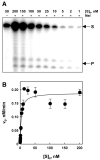Catalytic mechanism of Escherichia coli endonuclease VIII: roles of the intercalation loop and the zinc finger
- PMID: 17002303
- PMCID: PMC2542946
- DOI: 10.1021/bi060663e
Catalytic mechanism of Escherichia coli endonuclease VIII: roles of the intercalation loop and the zinc finger
Abstract
Endonuclease VIII (Nei) excises oxidatively damaged pyrimidines from DNA and shares structural and functional homology with formamidopyrimidine-DNA glycosylase. Although the structure of Escherichia coli Nei is solved [Zharkov et al. (2002) EMBO J. 21, 789-800], the functions of many of its amino acid residues involved in catalysis and substrate specificity are not known. We constructed a series of Nei mutants that interfere with eversion of the damaged base from the helix (QLY69-71AAA, DeltaQLY69-71) or perturb the conserved zinc finger (R171A, Q261A). Steady-state kinetics were measured with these mutant enzymes using substrates containing 5,6-dihydrouracil, two enantiomers of thymine glycol, 8-oxo-7,8-dihydroguanine, and an abasic site positioned opposite each of the four canonical DNA bases. To some extent, all Nei mutants were deficient in processing damaged DNA, with mutations in the zinc finger generally having a more profound effect. Wild-type Nei showed prominent opposite-base specificity (G > C approximately = T > A) when the lesion was 5,6-dihydrouracil or cis-(5S,6R)-thymine glycol but not for other lesions tested. Mutations in the Q69-Y71 loop eliminated this effect. Only wild-type Nei and Nei-Q261A mutants could be reductively cross-linked to damaged base-containing DNA. Experiments involving trapping with NaBH4 and the kinetics of DNA cleavage catalyzed by Nei-Q261A suggested that this mutant was deficient in regenerating free enzyme from the Nei-DNA covalent complex formed during the reaction. We conclude that the opposite-base specificity of Nei is primarily governed by residues in the Q69-Y71 loop and that both this loop and the zinc finger contribute significantly to the substrate specificity of Nei.
Figures




Similar articles
-
KsgA, a 16S rRNA adenine methyltransferase, has a novel DNA glycosylase/AP lyase activity to prevent mutations in Escherichia coli.Nucleic Acids Res. 2009 Apr;37(7):2116-25. doi: 10.1093/nar/gkp057. Epub 2009 Feb 17. Nucleic Acids Res. 2009. PMID: 19223326 Free PMC article.
-
Structure of the uncomplexed DNA repair enzyme endonuclease VIII indicates significant interdomain flexibility.Nucleic Acids Res. 2005 Sep 6;33(15):5006-16. doi: 10.1093/nar/gki796. Print 2005. Nucleic Acids Res. 2005. PMID: 16145054 Free PMC article.
-
Substrate specificity and excision kinetics of Escherichia coli endonuclease VIII (Nei) for modified bases in DNA damaged by free radicals.Biochemistry. 2001 Oct 9;40(40):12150-6. doi: 10.1021/bi015552o. Biochemistry. 2001. PMID: 11580290
-
Structural characterization of the Fpg family of DNA glycosylases.DNA Repair (Amst). 2003 Aug 12;2(8):839-62. doi: 10.1016/s1568-7864(03)00084-3. DNA Repair (Amst). 2003. PMID: 12893082 Review.
-
The Fpg/Nei family of DNA glycosylases: substrates, structures, and search for damage.Prog Mol Biol Transl Sci. 2012;110:71-91. doi: 10.1016/B978-0-12-387665-2.00004-3. Prog Mol Biol Transl Sci. 2012. PMID: 22749143 Free PMC article. Review.
Cited by
-
Excision of the doubly methylated base N4,5-dimethylcytosine from DNA by Escherichia coli Nei and Fpg proteins.Philos Trans R Soc Lond B Biol Sci. 2018 Jun 5;373(1748):20170337. doi: 10.1098/rstb.2017.0337. Philos Trans R Soc Lond B Biol Sci. 2018. PMID: 29685966 Free PMC article.
-
Active destabilization of base pairs by a DNA glycosylase wedge initiates damage recognition.Nucleic Acids Res. 2015 Jan;43(1):272-81. doi: 10.1093/nar/gku1300. Epub 2014 Dec 17. Nucleic Acids Res. 2015. PMID: 25520195 Free PMC article.
-
Cytotoxic Effect of Graphene Oxide Nanoribbons on Escherichia coli.Nanomaterials (Basel). 2021 May 19;11(5):1339. doi: 10.3390/nano11051339. Nanomaterials (Basel). 2021. PMID: 34069641 Free PMC article.
-
Competition for zinc binding in the host-pathogen interaction.Front Cell Infect Microbiol. 2013 Dec 24;3:108. doi: 10.3389/fcimb.2013.00108. eCollection 2013. Front Cell Infect Microbiol. 2013. PMID: 24400228 Free PMC article. Review.
-
Inhibitors of DNA Glycosylases as Prospective Drugs.Int J Mol Sci. 2020 Apr 28;21(9):3118. doi: 10.3390/ijms21093118. Int J Mol Sci. 2020. PMID: 32354123 Free PMC article. Review.
References
-
- Melamede RJ, Hatahet Z, Kow YW, Ide H, Wallace SS. Isolation and characterization of endonuclease VIII from Escherichia coli. Biochemistry. 1994;33:1255–1264. - PubMed
-
- Jiang D, Hatahet Z, Melamede RJ, Kow YW, Wallace SS. Characterization of Escherichia coli endonuclease VIII. J. Biol. Chem. 1997;272:32230–32239. - PubMed
-
- Wallace SS, Bandaru V, Kathe SD, Bond JP. The enigma of endonuclease VIII. DNA Repair. 2003;2:441–453. - PubMed
-
- Zharkov DO, Shoham G, Grollman AP. Structural characterization of the Fpg family of DNA glycosylases. DNA Repair. 2003;2:839–862. - PubMed
Publication types
MeSH terms
Substances
Grants and funding
LinkOut - more resources
Full Text Sources
Other Literature Sources
Molecular Biology Databases

